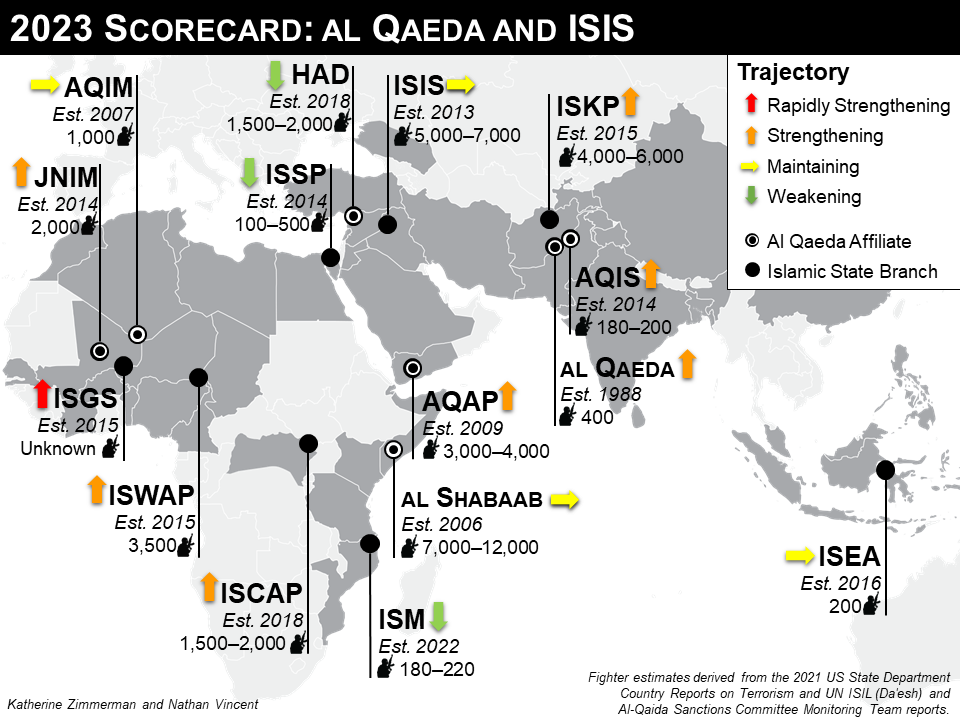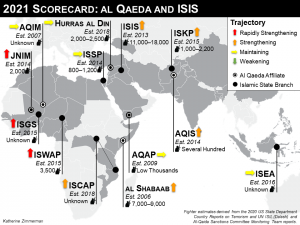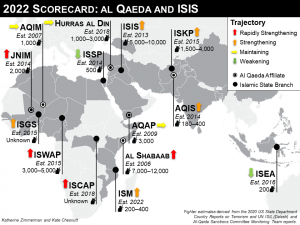{{currentView.title}}
September 11, 2023
The State of al Qaeda and ISIS in 2023
Editor’s note: This is the third annual assessment of the Salafi-jihadi movement. Last year’s assessment is available as “The State of al Qaeda and ISIS Around the World,” and September 2021’s assessment is available as “Al Qaeda & ISIS 20 Years After 9/11,” originally published for the Islamists.
The Salafi-jihadi threat persists across Africa, the Middle East, and into Asia. Al Qaeda– and Islamic State–affiliated groups are engaged in local conflicts and have sought ways to strengthen on the ground within popular insurgencies. Their focus on expanding in the Muslim world has not replaced aspirations to strike the West, however. Those groups that once demonstrated or sought to develop transnational attack capabilities still seek to target the United States and Europe, creating an ongoing requirement for counterterrorism activities.
Salafi-jihadi groups are set to strengthen as counterterrorism pressure lessens and local conditions worsen. They have continued expanding in West Africa, where a series of coups has destabilized the region, and the forced departure of the French military stopped certain counterterrorism operations. Weak governance, intercommunal conflict, and anti-government grievances create opportunities for groups to continue to expand in Burkina Faso, Mali, Niger, and Nigeria and threaten further Benin, Côte D’Ivoire, Ghana, Senegal, and Togo. The new Taliban-provided sanctuary in Afghanistan, which provides a destination for training recruits and some protection from counterterrorism pressure, has facilitated the growth of al Qaeda–affiliated groups in South Asia while the Taliban’s inability to secure Afghanistan’s territory enabled the Islamic State to strengthen.
Successes against Salafi-jihadi groups cannot be sustained without continued pressure on the groups. A renewed US presence supporting Somali security forces checked al Shabaab’s expansion, though the ongoing withdrawal of African Union peacekeeping forces raises concerns that the gains will not hold. Similarly, the ongoing US counterterrorism mission in Syria and support to the Iraqi security forces has limited the Islamic State’s ability to rebuild. Elsewhere, counterterrorism operations have weakened Salafi-jihadi groups where they have been unable to develop strong ties to local communities, such as in East Asia, Mozambique, and the Sinai.



Note: The established date for each group is given in the figure with the abbreviation “Est.” The abbreviations shown are al Qaeda in the Arabian Peninsula (AQAP), al Qaeda in the Islamic Maghreb (AQIM), al Qaeda in the Indian Subcontinent (AQIS), Hurras al Din (HAD), Islamic State Central Africa Province (ISCAP), Islamic State East Asia (ISEA), Islamic State Sahel Province (ISGS), Islamic State Khorasan Province (ISKP), Islamic State Mozambique (ISM), Islamic State Sinai Province (ISSP), Islamic State West Africa Province (ISWAP), and Jama’at Nusrat al Islam wa al Muslimeen (JNIM). Note that ISGS was renamed “Islamic State Sahel Province” in March 2022. For clarity, ISGS will continue to refer to the Sahel Province while ISSP will refer to Islamic State Sinai Province.
Behind the Scorecard
Africa. Salafi-jihadi groups are thriving in Africa, which has become the world’s epicenter of Salafi-jihadi expansion. The compounded effect of multiple coups in recent years across the Sahel, extending from Guinea to Sudan, has been a rise in instability and lifting of counterterrorism pressure. Meanwhile, Salafi-jihadi groups exploit local socioeconomic, ethnic, and political fragility to strengthen.
- In East Africa, al Shabaab continues to demonstrate sophisticated attack capabilities in the midst of an ongoing counterterrorism offensive. The group increased the rate and severity of its attacks in Somalia’s capital, Mogadishu, and more recently in northeastern Kenya, conducting 19 attacks in June 2023. Somali forces recaptured a third of al Shabaab–controlled territory after US counterterrorism forces redeployed to Somalia in May 2022, but al Shabaab’s strongholds remain. Somali forces have not recaptured al Shabaab–controlled territory in south-central Somalia. An ongoing drawdown of African Union peacekeeping forces, which have been transitioning their responsibilities to Somali forces, raises concerns over whether the recent gains against al Shabaab will hold. Al Shabaab continues to seek to develop transnational attack capabilities.
The Somali Islamic State branch serves as a node connecting Afghan, African, and Yemeni branches to the Islamic State senior leadership cadre in Iraq and Syria. A US counterterrorism raid in January 2023 killed Bilal al Sudani, a senior Islamic State operative and al Karrar office official who helped the Islamic State expand on the African continent and financed Islamic State operations globally.
Both the Islamic State Mozambique (ISM) and Islamic State Central Africa Province (ISCAP) retain public affiliation with the Islamic State, though how much influence the senior Islamic State leaders retain over the groups is unknown.
Regional counterterrorism forces deployed to Cabo Delgado province in northern Mozambique have made gains against ISM. Leadership attrition and reduced operational capabilities—in part due to the local economy’s collapse during the conflict—have weakened the group, but the remaining fighters are battle hardened. ISM may be conducting outreach in local communities to develop relationships that will help it sustain strength under pressure.
ISCAP expanded its area of operations westward due to Congolese and Ugandan counterterrorism operations in its traditional strongholds near the Democratic Republic of the Congo’s eastern border with Uganda, nearly tripling its range within four months of the launch of joint military operations. The lethality of its attacks has also risen as ISCAP attempts to maximize civilian casualties. Future counterterrorism operations will likely enhance ISCAP’s operational capacity and amplify its recruiting capabilities.
- In North Africa, Egyptian counterterrorism pressure on the Islamic State Sinai Province (ISSP) significantly weakened the group. ISSP has relocated to western Sinai and may have only conducted one attack in 2023: an unclaimed attack on an Egyptian military vehicle in southern Sinai in March 2023. Al Qaeda in the Islamic Maghreb (AQIM) has kept a low profile, refraining from conducting terrorist attacks. It sustains safe havens in southern Libya from where it supports its subordinate, Jama’at Nusrat al Islam wa al Muslimeen (JNIM), in the Sahel. AQIM’s emir described the Sahel as the “epicenter” of jihad in March 2023.
- In West Africa, the Malian and Burkinabe military juntas have not been able to weaken JNIM or the Islamic State in the Greater Sahara (ISGS) and have continued to undermine international counterterrorism support, leading the UN to declare it will withdraw its peacekeeping force in Mali by the end of 2023. JNIM has encircled both capitals while expanding southwestward in Mali and southward into Benin, Côte d’Ivoire, and Ghana.JNIM and ISGS continue to fight over influence in northeastern Mali, with each drawing support from different local communities. JNIM has been unable to prevent ISGS from expanding in northeastern Mali and the tri-border region with Burkina Faso, Mali, and Niger, but it is using the threat of ISGS’s expansion to strengthen ties with vulnerable local actors in northern Mali. JNIM has sustained a population-centric operation, exploiting weak governance, Malian army and Wagner Group abuses, and instability to build local support.
ISGS has strengthened without French counterterrorism pressure. It has more than doubled its territorial control over the past year and begun levying taxes and enforcing its interpretation of shari’a in Mali’s northeastern Menaka region. ISGS will probably seize openings presented by the July 2023 coup in Niger to expand, should Nigerien security forces reduce operations targeting the group.
The Islamic State West Africa Province (ISWAP) persists as a growing threat in Nigeria. It has instituted a loose form of government, collecting taxes from populations under its control. It has also conducted attacks in new areas, such as the northern Nigerian state of Jigawa. Additionally, ISGS was almost certainly planning a terror attack in Abuja, Nigeria’s capital, in late October 2022 and may have sought to assassinate the Nigerian president late December 2022.
Al Qaeda–linked Ansaru may be aligning or coordinating with local bandits in northwestern Nigeria after resuming operations in 2020. The group has remained mostly dormant operationally, however, despite its rising use of propaganda.
Middle East. Salafi-jihadi groups in Iraq, Syria, and Yemen have lost key leaders and operatives but remain local threats. They also seek to develop and refine transnational attack capabilities. Counterterrorism pressure has prevented the groups from recapturing terrain and disrupted operations, but ongoing conflict and instability and rising sectarian tensions create opportunities for the groups to restrengthen.
- In Iraq and Syria, counterterrorism pressure on the Islamic State in Iraq and al Sham has caused the group to adapt by changing its command structure and limiting attacks to rebuild its rank and file. Losses have occurred primarily within the Islamic State’s global senior leadership, including those leading efforts to conduct attacks in Europe. However, ISIS has adapted to absorb the impact of leadership attrition. ISIS remains resilient and has sustained a low-level insurgency in Iraq while conducting targeted attacks in Syria, especially against prisons to release key operatives. It has particularly strengthened in central Syria, demonstrating the ability to stage maneuver forces as part of a multistage campaign. Increasing Turkish aggression toward the Syrian Democratic Forces—the US counterterrorism partner in northeastern Syria—may reduce pressure on ISIS in the coming year. Iraqi counterterrorism pressure has suppressed, but not eliminated, the ISIS threat.
In northwest Syria, Hayat Tahrir al Sham (HTS) controls territory in Idlib province. Though HTS has sought to distance itself from its Salafi-jihadi roots, it provides sanctuary to foreign terrorist groups such as the Eastern Turkistan Islamic Movement and Khatiba al Tawhid wa al Jihad. HTS has cracked down on the presence of the al Qaeda–linked Hurras al Din (HAD), including killing or capturing senior HAD operatives. HAD may be seeking to develop transnational attack capabilities to strike the West.
- In Yemen, al Qaeda in the Arabian Peninsula (AQAP) remains intent on redeveloping its transnational attack capabilities and persists as a regional threat. Its top leadership remains intact, though attrition has taken its toll on the group’s operations. AQAP has launched a counteroffensive against counterterrorism forces in southern Yemen, showcasing new capabilities with unmanned aerial systems and escalating intensity. May 2023 was the highest spike in AQAP operations since 2015. The Islamic State in Yemen remains on a downward trajectory, serving as a financial and facilitation link between IS-Somalia and Islamic State Khorasan Province (ISKP) in Afghanistan.
South Asia. Taliban control of Afghanistan continues to benefit regional Salafi-jihadi groups. Groups in al Qaeda’s network have taken advantage of sanctuary in Afghanistan to recruit and train fighters, whereas the Islamic State has deepened its investment in its branch in Afghanistan, which now serves as a local hub for a regional Islamic State network.
- In Afghanistan and Pakistan, the Taliban continues to provide sanctuary to al Qaeda and al Qaeda in the Indian Subcontinent (AQIS). Al Qaeda’s assessed but unannounced emir is Saif al Adel, who may have freedom of movement between Iran and Afghanistan and may be seeking to increase influence over al Qaeda’s affiliates, especially AQAP. Senior al Qaeda figures remain in Afghanistan under the Taliban’s protection, and the group has established new training camps and safe houses where it sends new recruits. Al Qaeda is rebuilding its transnational attack capability.
Al Qaeda’s relationship with the Tehrik-e-Taliban Pakistan (TTP) has been reinvigorated in the Taliban-provided sanctuary in Afghanistan. AQIS’s relationship with the TTP may be deepening, as reports indicate it may be helping the TTP work around certain Taliban-imposed restrictions in Afghanistan and providing strategic guidance to the TTP’s operations in Pakistan. AQIS seeks to expand outside Afghanistan-Pakistan into Bangladesh, India, and Myanmar. The Haqqani network holds key positions in the Taliban administration, and though there is open disagreement with the Taliban emir’s decisions, they are obeyed. The TTP broke its cease-fire with the Pakistani government and has since escalated attacks in Pakistani territory.
ISKP’s growth has stalled after the initial surge in 2021, though it remains the greatest terror threat in the region. It almost certainly acquired some of the matériel abandoned during the 2021 withdrawal. ISKP seeks to undermine the Taliban’s legitimacy and has begun striking diplomatic targets in Afghanistan—including the Pakistani and Russian embassies and a Kabul hotel frequented by Chinese—and projecting force into Pakistan as its operational capabilities have matured. The group also plays a key role in the Islamic State’s global threat, directing operatives in the Maldives and holding aspirations to attack the United States.
- In Southeast Asia, counterterrorism pressure has suppressed terrorist activities, although ISEA remains active. Foreign fighters have traveled to the region from the Middle East to conduct attacks.
Leadership. US and partnered counterterrorism operations have led to significant leadership losses for al Qaeda and the Islamic State. They both have adapted to such attrition, however. Rapid turnover in the Islamic State’s senior leadership, especially its overall leader, has further decentralized and flattened command structures. Secrecy around the Islamic State leader’s identity has not led groups to question his authority publicly. Al Qaeda has spent the past year without publicly recognizing a new leader, who is assessed to be Saif al Adel.
As of September 2023, key al Qaeda leaders include
- Saif al Adel. Assessed to be al Qaeda’s emir, though al Qaeda has not released a statement confirming his appointment or Ayman al Zawahiri’s death in August 2022.
- Abdul Rahman al Maghrebi. An al Qaeda shura council member, al Sahab media director, and head of external communications.
- Abu Ubaydah Yusef al Annabi. AQIM’s emir since 2020 and veteran al Qaeda member.
- Khalid Batarfi. AQAP’s emir since 2020.
- Ahmed Umar (Abu Ubaidah). Al Shabaab’s emir since 2014.
- Iyad ag Ghaly. JNIM emir with long-standing ties to AQIM.
- Samir Hijazi. HAD’s leader.
- Sami al Uraydi. Senior HAD member and veteran al Qaeda operative.
- Osama Mahmood. AQIS’s emir since 2019.
As of September 2023, key Islamic State leaders include
- Abu Hafs al Hashimi al Qurayshi. Islamic State leader succeeding Abu al Hasan al Hashimi al Qurayshi, who was killed in spring 2023.
- Tamim al Kurdi. Leader of the Afghanistan-based al Siddiq office, appointed by Islamic State senior leadership in 2020.
- Abdul Bara al Sahrawi. ISGS’s emir since 2021.
- Abu Musab al Barnawi. Served as ISWAP’s emir between August 2016 and March 2019, before being appointed head of the Islamic State’s al Furqan office, which is based in the Lake Chad region and coordinates regional branches, in May 2021. His current status is unclear. The Nigerian government reported in September 2021 he had been killed, but unsubstantiated reports later emerged that he was alive.
- Seka Musa Baluku. Leader of ISCAP.
- Abu Yasir Hassan. Leader of ISM, as identified by the US.
- Shahab al Muhajir. ISKP’s emir, an Iraqi who defected from the Haqqani network and al Qaeda, since April 2020.
- Abu Hajar al Hashemi. ISSP’s emir. He may have served previously as an Iraqi army officer.
- Abdul Qadir Mumin. IS-Somalia’s emir and founder. He defected from al Shabaab.
- Abu Zacharia. Late leader of ISEA, killed in June 2023.
Salafi-Jihadi Attacks with American Casualties (2022–23)
Salafi-jihadi groups such as al Shabaab, AQAP, and ISIS have pursued external attack capabilities but have not conducted a terror attack in the US since the December 2019 shooting in Pensacola, Florida. ISKP’s suicide attack in Kabul, Afghanistan, in August 2021, remains the most recent attack against US forces. US forces on counterterrorism missions are no longer engaged in combat operations, limiting the opportunities for Salafi-jihadi groups to target them.
The authors thank the Critical Threats Project’s Salafi-jihadi team, especially analysts Brian Carter, Kathryn Tyson, and Liam Carter for their research and contributions to this assessment.
